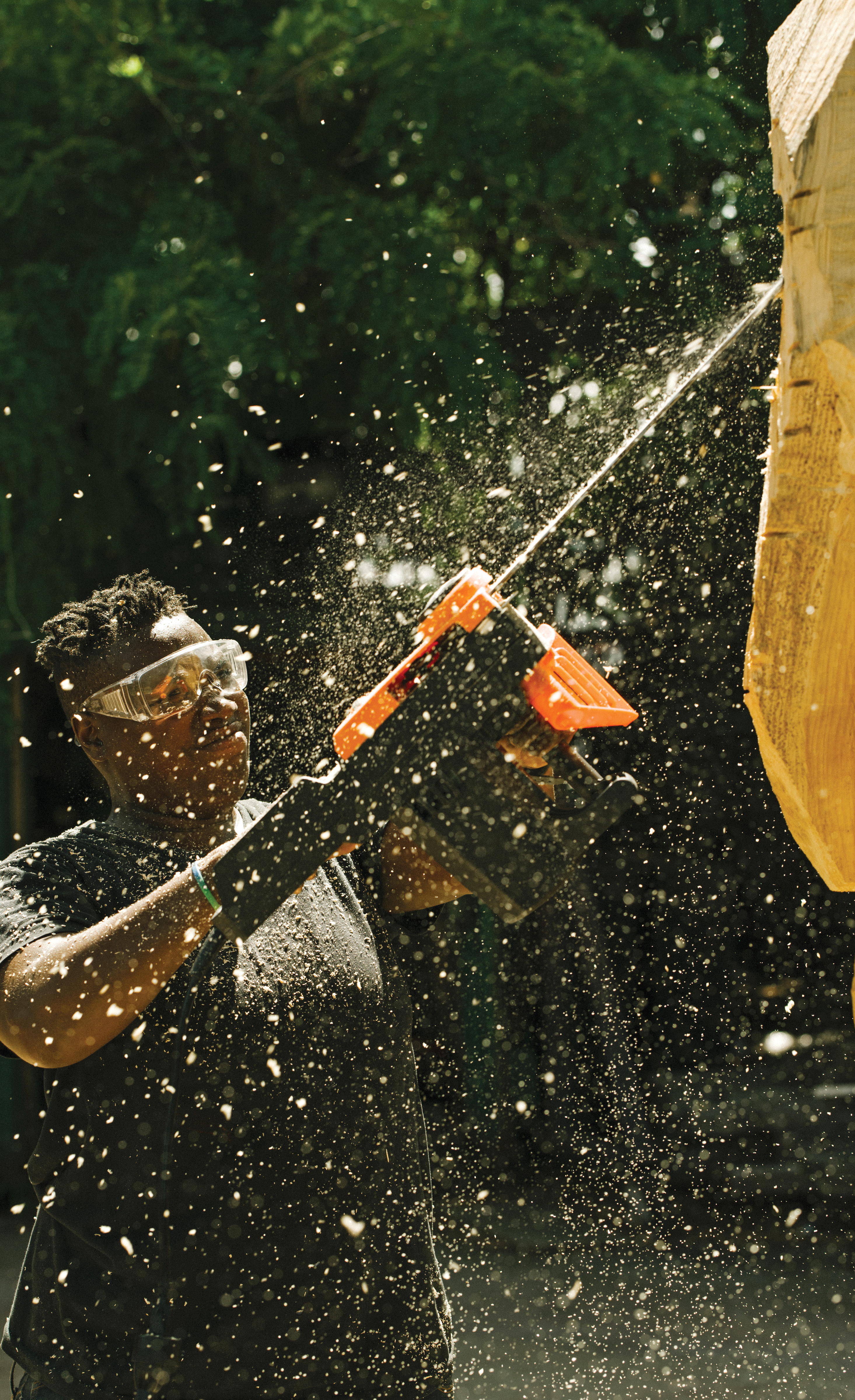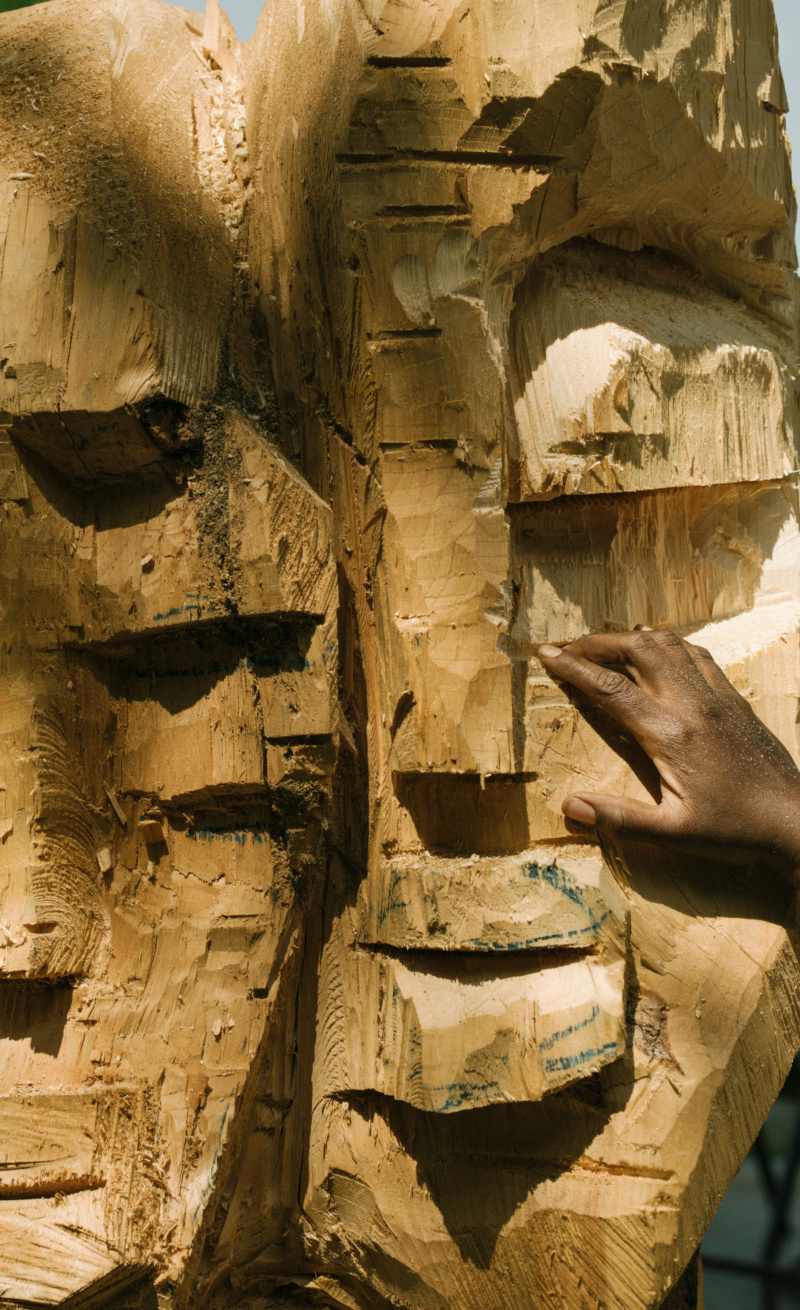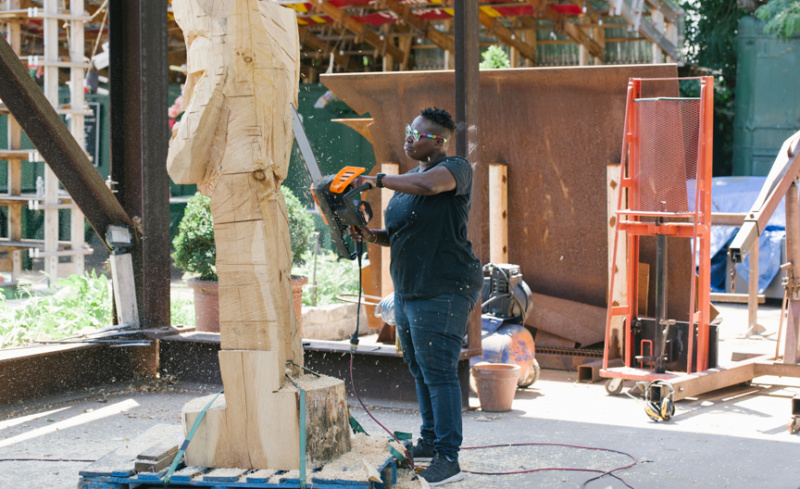
I meet up with sculptor Leilah Babirye at the diner La Bonbonniere in the West Village on a sweltering Monday afternoon. Before we even sit down at our proudly unglamorous Formica table, Babirye is telling me a story. Her brother is threatening to disinvite her friends from his upcoming wedding in Uganda, where she is from and was forced to flee in 2015 after being publicly outed as a lesbian. “My friends there are all activists and openly gay,” she explains. “But he said, ‘I invited pastors, elders and people from the church—your friends will come with their locks, women dressed like men, men dressed like women.’” She smiles to herself as if to say: His loss—it won’t be a party without them.
Since finding a home in the queer scene of Kampala, Uganda, Babirye has insisted on bringing her community with her everywhere she goes, and most especially into her work as a sculptor. For her first solo exhibition this past spring at Gordon Robichaux, Babirye made activist material out of her utopic, celebratory vision of queer life. The show, “Amatwaale Ga Ssekabaka Mwanga II (The Empire of King Mwanga II),” paid homage to the little-known, openly bisexual King Mwanga II who, in the late 19th century, fought against the colonial rule of Uganda by Western missionaries. Colonization would eventually poison the people against long-held cultural norms of matriarchy, feminine worship and queerness, helping to create the present-day environment of open hostility and homophobia that forced Babirye into exile.
Her show offered an alternate future, a gender- and power-fluid take on King Mwanga II’s kingdom. A series of wood and ceramic sculptural masks, named for contemporary Ugandan princes and princesses, their genders and titles conflated, stood on pedestals in the center of the room reigning supreme. “I picked names from the present day because that is what my generation is familiar with… We need to make our own history and legacy,” Babirye explains. Adorning both the masks and the sculptural reliefs on the walls of the gallery were found materials such as chains, nails, plastic bags, mousetraps, old cell phones and locks. Babirye’s choice to use trash in the work is intentional—the pejorative for a gay person in the Luganda language is ebisiyaga, which means sugarcane husk. “It’s rubbish,” explains Babirye, “the part of the sugarcane you throw out.”
Babirye’s life was set to go on a very different track back in 2006, when she was on her way to check out the law school at Kampala’s Makerere University and came upon the university’s art school instead. There she saw Dr. Lilian Nabulime, a well-known artist and star of the university sculpture department, bent over a giant tree stump carving. “When I saw Dr. Lilian doing something I thought was supposed to be done by men, I said, ‘Could I do this?’” Nabulime encouraged Babirye to come to the art school and study sculpture with her.

Believing that there was no future for her in art, Babirye’s father insisted that she take courses in computer science and engineering; it would be another year before he would agree to pay her tuition for art school. Once there, and under the guidance of a prodigiously accomplished female faculty (including Nabulime, Margaret Nagawa, Dr. Rose Kirumira and Sylvia Katende, all of whom participated in the pivotal 1995 “Women on the Move” show at Nommo gallery in Kampala) geared toward female empowerment through the instruction and practice of art, Babirye thrived and produced. Students were taught European sculptural techniques used in the works of Alberto Giacometti and Henry Moore, as well as methods from African sculptural traditions, like carving and burning. (A fusing of styles and methods took hold of her process early on: She would fashion her reproductions of Henry Moore’s reclining figures using bloated animal bones.) For her major, she focused on Pan-African women’s hairstyles—sculptures of women with elaborately architectural braids, wigs, twists and locks fashioned out of cloth, yarn, chains, old film—that she would stay late in her studio every night working on. “My love was my art. I had no time for dating.”
After she graduated, she began trying to sell her work and make a living as an artist. She also started going out to gay bars in Kampala, solidifying important relationships and developing a strong connection to the queer community. At the end of her gap year, her father and professors were pressuring her to go back to university and get an advanced degree in sculpture. She began looking for a dissertation topic. On television, she had seen footage of the memorial for David Kato, a young gay rights activist who had been violently murdered in his home. His friends, many of whom she knew from the community, were wearing masks over their faces at the funeral to protect their identities. The televised images of her friends’ concealed faces was a watershed moment for Babirye.
She had found her dissertation topic: She would make masks as a way to talk about the struggle the LGBT community faces in Uganda. “That’s when I started making real art,” she says. “I thought, why not be wild and come out now? I was having issues with my family; my brother and dad were hearing rumors… My anger popped out. I was going to do things my way, not my parents’ way.” Nor the way of her mentors. When she told her professors what the masks would represent, they rejected the topic outright and left the room outraged.
In the years that followed, Babirye went ahead in her pursuit of new methods and meanings, her art becoming her activism. There’s no mask-making or decorative wood- carving techniques unique to Central Africa; to learn the basics, Babirye sought out a local group of artisans that were producing masks in the West African tradition. Since the skills were borrowed and new to her, she had to get creative with the form and materials, a transcultural alchemy that helped her develop her own style and point of view, and a body of work reflective of the diversity of African art traditions.

In the homophobic climate that would reach its climax with Uganda’s infamous anti- homosexuality bill in 2013, Babirye’s work became increasingly urgent. In 2014, she was publicly outed in a massive inflammatory story in a local tabloid. Babirye had applied to the Fire Island Artist Residency in New York and was accepted. Fearing for her life, she left Kampala in 2015 with a travel visa and hasn’t returned since. And on Valentine’s Day of this year, she was granted asylum, an arduous process three years in the making.
As a fellow at Socrates Sculpture Park in Queens, where she made a 12-foot sculpture that will be part of the Socrates Annual opening October 7, Babirye was given a production grant and daily access to the park’s studio and facilities. Unsurprisingly, she is keeping similar hours to the ones she did in art school: “The first to arrive and last to leave,” her gallerist Sam Gordon tells me. As to where her imagination is currently drifting, she muses affectionately: “I think I need to return to hair.” In an art world loaded with empty, trending gestures towards resistance and freedom, Babirye’s sincerity cuts through the noise, an embodiment of lived activism. Perhaps this is because Babirye never forgets whom her work is for. Love for her community fuels her sculptural forms, forms that exhume a dense tangle of queer struggle, joy and detritus, and get free.
Craving more culture? Sign up to receive the Cultured newsletter, a biweekly guide to what’s new and what’s next in art, architecture, design and more.










 in your life?
in your life?

